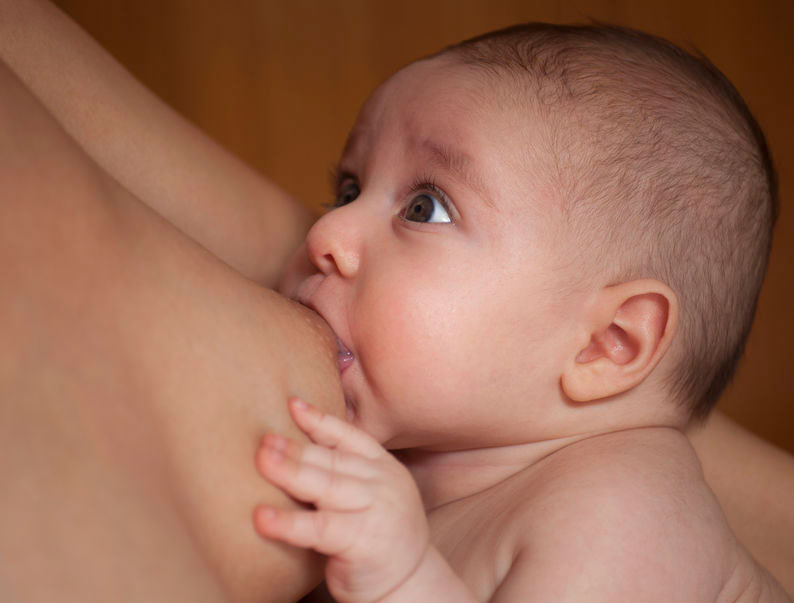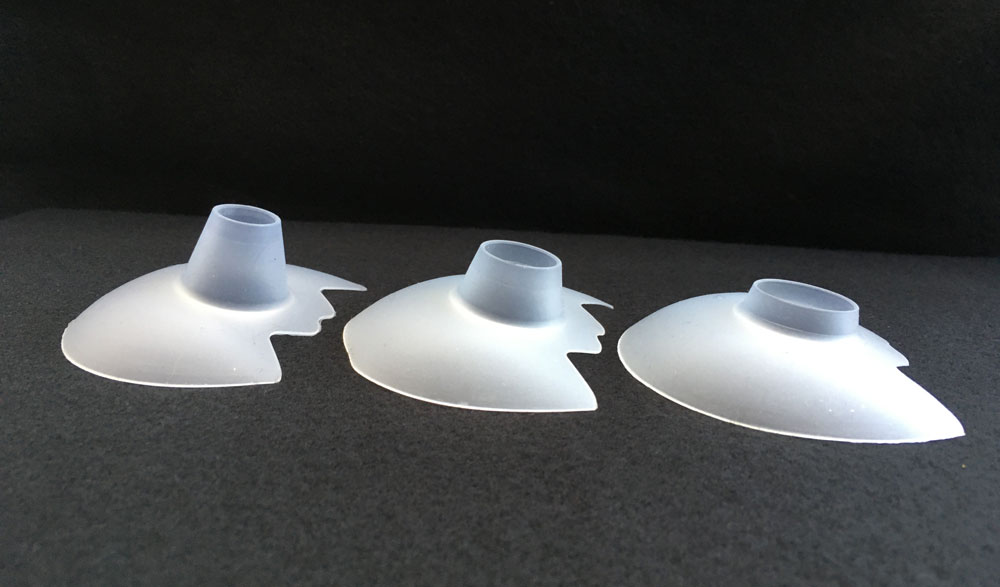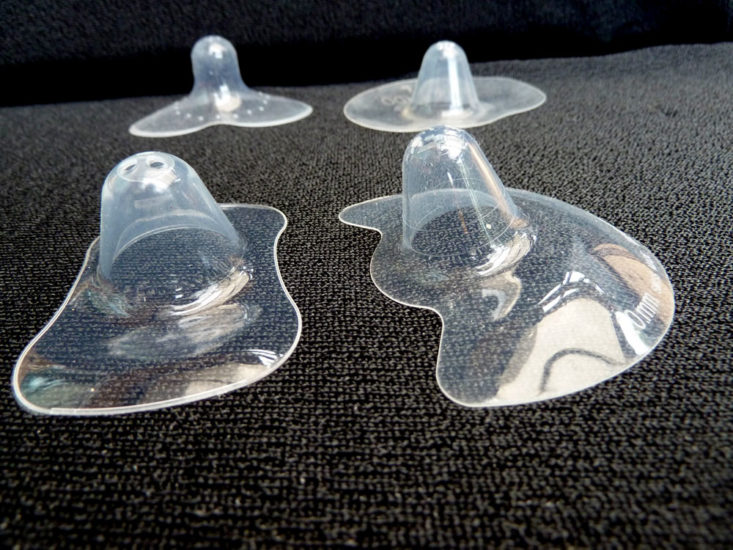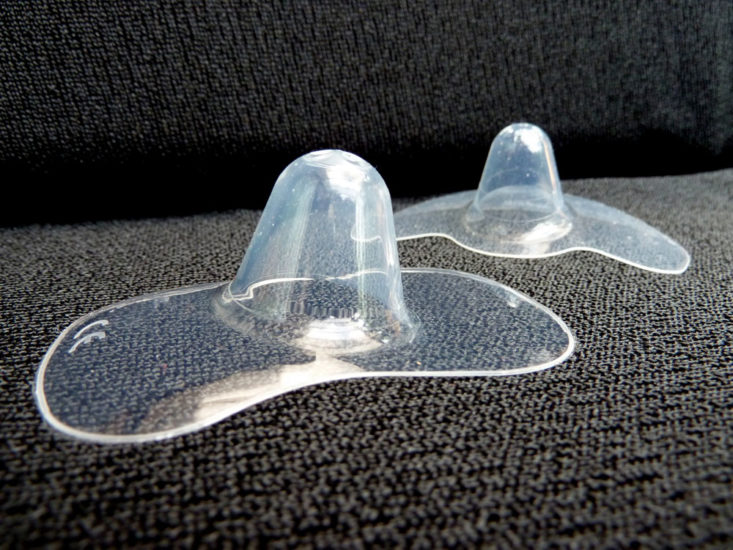Nipple shields can be a useful gadget to help a baby breastfeed in some situations. But what if a mother is ready to stop using them but her baby isn’t? While simply removing the nipple shields might work for some babies, other babies refuse to close their mouths properly (latch) on a naked breast and get very upset if they can’t feel the shield that they are used to. This article shares tips and ideas for weaning from a nipple shield and is a companion article to Nipple Shields Good or Bad? and How to Get Baby Back to Breast.
Top tips
- Ensure your baby is not too hungry when he practices breastfeeding without nipple shields so he is calm.
- Avoid your baby becoming too frustrated or upset. If a baby is getting very upset with the idea of latching without the shield, continue the feed as normal with the shield in place and try again at another feed or on a different day. It is important that breastfeeding doesn’t become a source of conflict and stress.
- Try to stay relaxed. Babies are very in tune with their mothers and if mum feels anxious about latching, baby may also feel anxious. Help your baby stay calm with eye contact, smiling at him, and talking to him.
A note on flat or inverted nipples
If the reason you have been using nipple shields is due to having flat or inverted nipples, it can help to evert your nipples and shape the breast before your baby latches without the shield. Everting your nipples—coaxing out an inverted nipple or making a soft, flat nipple erect—helps your baby feel the nipple on his palate to stimulate the suckling reflex. In addition shaping the breast or flattening it slightly—just as you would flatten a big sandwich full of salad before you take a bite—may help your baby get a big mouthful of breast and nipple (a good latch). Pumping just before latching can be useful to bring out the nipple with the bonus that milk will be flowing ready to reward your baby if he latches. See more tips in Breastfeeding With Inverted Nipples and Flat Nipples and see Latching Tips for more information about getting a good latch and shaping the breast to help with this.
Ideas for weaning from a nipple shield
#1 Try breastfeeding without the shield (it may work!)
Some babies will be able to make the change from shield to naked breast without too much difficulty. Try our step by step guide.
Step by step
- Evert your nipples if you have soft, flattish nipples by gently rolling your nipples between your fingers, by holding a cold cloth against them or using a breast pump for a few minutes.
- Get your milk flowing prior to latching so your baby can get an instant reward of milk. You can use a breast pump or hand express to trigger the let-down.
- Shape the breast as needed with your fingers to help your baby get a bigger mouthful of breast tissue. See Latching Tips for more information.
- Try to relax. Babies can pick up on any tension so try to relax your shoulders, smile, hum a tune or even stand and sway gently from side to side for the latch.
- Bring your baby to the breast just as you would with the nipple shield in place. Some mothers find the cross cradle hold can give more control for the latch—one hand supports baby’s back and shoulders and one hand shapes the breast if needed. But use any position that feels comfortable, see Breastfeeding Positions for Newborns.
- Wait for the moment baby opens his mouth wide then bring him quickly and confidently towards the breast. If he hesitates at the moment he feels skin instead of nipple shield, try rocking him gently and singing or talking to distract him. Maintaining eye contact, smiling and praising him may also help.
- Using gentle breast compressions may help to keep the milk flowing so your baby gets the idea that milk can come from skin as well as silicone. See What is Breast Compression? for more information about this technique.
- Repeat. Once you have had one successful latch for part or a whole feed you can build on this by repeating the steps each time you breastfeed.
If your baby cries and refuses to latch, calm him and feed as usual with the nipple shield. You can try again or try one of the other steps below at the next feed, the next day or in a few days time.
#2 Start the feed with the shield as normal… then remove it
A variation of #1 is to start a breastfeed with the shield in place, then remove it part way through the feed.
Step by step
- Start breastfeeding with the nipple shield in place.
- Once milk is flowing well, and your baby has had a little breast milk to take the edge off his appetite, break your baby’s latch from the breast by slipping a finger between his gums.
- Remove the shield and quickly bring baby back to the breast. Shape the breast if needed to help your baby get a bigger mouthful (see Latching Tips).
- Some swaying and gentle humming or singing may distract your baby enough that they do not notice that the shield has gone. Try to keep your own body relaxed rather than tense so your baby also stays relaxed.
- Use breast compressions if needed to keep milk flowing at a faster pace.
If your baby refuses to latch back on, finish the feed with the shield and try again another time or try one of the other steps below.
#3 Try skin-to-skin time
If simply offering your baby a breast to latch instead of a nipple shield, or slipping off the shield mid-feed doesn’t go well, help your baby associate the naked breast as a safe and comforting place to be without pressure to latch. Familiarise your baby with the feeling of skin by holding your baby in skin-to-skin contact between your breasts or in a laid back position where your baby is on his tummy, lying on your tummy. Another option could be to try letting baby suck on a clean finger with a well trimmed nail to get used to the feeling of skin in their mouth. See our article Why Skin-to-Skin? for an explanation and videos of how reclining breastfeeding positions and skin-to-skin contact (take off those scratch mittens!) are more likely to help a baby’s latching instincts. Given the right opportunity a baby may latch on their own.
Step by step
- Relax together skin-to-skin or lightly dressed, or try taking a warm bath together with low lighting. Our article How to get Baby Back to Breast has information on a technique called rebirthing that helps some babies to latch.
- Don’t worry too much if baby doesn’t latch, the goal is for him to feel happy, safe and loved while he explores the smell, taste and feel of your skin.
- A fairly full breast will reward baby if he latches but ideally your baby will not be too hungry during skin-to-skin time to avoid him getting frustrated.
- A little finger feeding prior to latching can help some babies—the skin of the finger is closer to the feeling of a breast than silicone. Finger feeding can also encourage the same tongue function needed for breastfeeding. See our article on finger feeding if this is something you are interested in learning more about.
- If baby does attempt to latch, shape the breast to help them if needed, smile and praise them gently.
If your baby gets hungry but will not latch, feed him as usual with the shield in place to avoid him getting upset with the breast.

#4 Try latching when your baby is sleepy or in light sleep
Many babies will breastfeed in light sleep so this can be a good time to try a feed without the nipple shield because they will be less aware of the different sensation in their mouth.
Step by step
- Pick a moment when your baby is in light sleep and cradle him in a breastfeeding hold with his cheek in contact with the breast.
- When he opens his mouth to search for the breast, bring him in close and try the breast shaping, swaying, humming techniques described in #1 and #2 above if needed.
- If your baby latches, breast compressions can keep milk flowing.
- Alternatively start the feed with the shield and when baby becomes sleepy, slip off the shield and see if he will latch again to the naked breast. Avoid waiting too long or your baby may drift into a deep sleep and may not latch again, with or without a shield.
If your baby wakes fully and refuses to latch, either pop the shield back on and try removing it again part way through the feed (#3 ), or you could continue the feed as usual this time.
#5 Try different positions
Sometimes trying a different breastfeeding position to the usual one can help to break the expectation of the silicone nipple shield and your baby might be more open to try something new. He might think it is a game or a new toy instead of a feed. For example with an older baby:
For a slightly older baby, using new positions in a playful way may help turn breastfeeding into more of a casual fun thing, rather than an activity that creates tension and anxiety. Trying different positions and places for latching on—in the bath, the garden, kitchen, while walking about, in a dark room, even dangling a breast over him when he is on the floor (while you both giggle)—may all help make it more of a fun thing to do.
Try to keep this playful and pick a time when baby is not going to be overly hungry.
#6 Try different shapes of shield
Shields come in different shapes and sizes. Some are shaped so that your baby’s nose has contact with your breast. Others are butterfly shaped allowing even more skin contact above and below the nipple. More skin contact below the breast will allow your baby to taste your skin and get used to the new sensation on his tongue. Trying a different shape may help some babies move towards weaning from a nipple shield—if the style suits you as a nipple protector.
One American company has devised a Nipple Shield Weaning Kit that may work for some babies and can be shipped internationally. The kit comprises a three step system of progressively shorter open ended nipple shields made from a very soft and thin food-grade silicone.

#7 Stop trying for a while
If your baby gets frustrated with your attempts to get rid of the nipple shield, calm him back down and resume the feed with the nipple shield for that feeding. If he seems to be getting fussy at every feed because he is anticipating interruptions, it may be helpful to stop trying for a couple of days or a week and resume pleasant skin-to-skin time instead (#3).
Let your baby decide
Each day your baby gets older and more skilled and many mothers have found their babies leave the shield behind when the time is right for them. Many babies have suddenly stopped using them at two, four or six months of age or older. And some mothers have just carried on using the nipple shields. Nipple shields are not the end of the world if your baby is able to transfer milk and is gaining weight well. If your baby is not gaining weight well or your milk supply is low, an IBCLC lactation consultant can help you increase your milk supply and see How to Make More Milk.

# 8 Find support
Finding support from other mothers at a breastfeeding support group can be very helpful. Experienced breastfeeding mothers may have their own tips that worked for them and it will be reassuring to hear their success stories. Older babies may even benefit from watching other babies latch on without shields. It may also be useful to see an experienced breastfeeding specialist such as an IBCLC lactation consultant for one-to-one help and support.
What not to do
Don’t force baby to the breast
Don’t let your baby get constantly frustrated and upset at each feed or they might begin to associate feeling unsafe with breastfeeding. If your baby is getting upset at the breast even with nipple shields in place it is time to take a step back or take a break. See the section “Baby crying, arching and pulling away?” in How to Get Baby Back to the Breast.
Don’t cut away the shield
Some mothers may have heard friends or family suggest gradually cutting away the shield to make it smaller and smaller so your baby gradually gets used to less shield and more breast. Nipple shield manufacturers do not recommend this at it could leave sharp edges to damage your baby’s mouth or loose fragments could be a choking hazard. See #6 for information about different shaped shields that allow more skin contact, including a commercial nipple shield weaning kit with progressively shorter open ended shields.
When baby latches but breastfeeding hurts
Depending on the reason you started using nipple shields in the first place, there may still be an underlying issue with your baby’s latch. If your baby starts latching to the naked breast but you find breastfeeding is painful, check out Why Does Breastfeeding Hurt? see our Latching Tips and check in with your IBCLC lactation consultant. Your lactation consultant will be able to make suggestions to improve latch, positioning and tongue function, the most common causes of painful feeding.
Summary
There are several tips to help with weaning from a nipple shield. Some babies will move on from them quicker than others. If milk transfer and weight gain are good, but weaning from a nipple shield is taking longer than expected, remember you’re still breastfeeding even if you would prefer it to be without the shield. For advantages and disadvantages of nipple shields see Nipple Shields Good or Bad?

